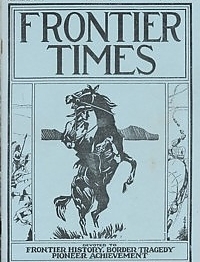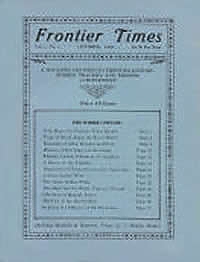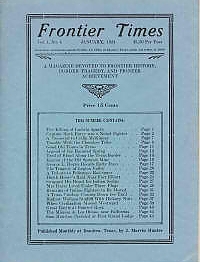By using our website, you agree to the use of cookies as described in our Cookie Policy
Magazines & Instant Downloads
Vol 11 No. 05 - February 1934
A Cowboy Poet
by John White
Account of famous cowboy poet, D. J. O'Malley.
Mentions: the N-Bar-N ranch in Eastern Montana , Will C. Barnes, western writer and for many years connected with the United States Forestry Service, "The Stampede on the Turkey Track Range. ", R. J. Stovall,
"Fighting Bill" Tucker Was Hero
It was half a century ago that Tucker had the fight that gave him the name that has clung to him ever since There never was such a battle before and there never will be again, pioneers will tell you. The irresponsible murder of a 14 year old boy, raised Tucker’s wrath, and the result was a series of fist fights in which the wiry 175-pounder was the invariable victor. So from that day forth Tucker was known as "Fighting Bill."
Mentions: Hector and Achilles, Kilrane and John Sullivan . Double Mountain in Stephens County, Sam Bass in Collin County, Breckenridge,
Era of Wool and Sheep in Nueces Valley
By Coleman McCampbell. From 1870 to 1880 sheep raising was the most profitable industry in Nueces and Duval counties. Land was cheap and, unlike other sections of the, Southwest, there was no friction between the sheep-owner and the cowman. There were over a million sheep, (Capt. Richard King had over 40,000 at his big cattle ranch) in the two counties; and, for several years, Corpus Christi was the largest wool market in the world. It bought and shipped annually from seven to twelve million pounds of wool. This is the story.
Writes About Packsaddle Mountain Fight
by Clark J. Lee as he wrote to the Fredericksburg Standard, regarding the infamous Packsaddle Indian fight in Llano county, which took place in the month of August of 1873. Also contains some details of some early history of Gillespie County, especially of the Willow Creek Community. Mentions: the name of Pressler, who was teaching school, in Dr. Afthaus' private residence oil North Grape Creek, Wm. Althaus, Chas. Althaus, Gus Koennecke, James Moore, Comanthe school house in Blanco County., Wm. Rabb, the Wilson boys, Honey Creek in Llano County, James Moss, Steve Moss, William (Bill) Moore, Robert (Bob) Ayers, Bull Head Mountain, Gambol Spring and Cut-off Gap, Bob Brown, Junction City,
Collection Data Relative to Dawson Massacre
By Houston Wade. Compilation of data/names relative to the devastating "Dawson's Massacre".
Mentions: Fayette County, Captain Nicholas Mosby Dawson's command, Here is a specimen from the list: Melds, Charles Farris . . Faisan, Nathaniel W. . Eastland, Robert . Dickerson . . Dawson, Nicholas M. . Griffin, Joe (c) Harrell, Milvern Higgerson, John Hall, Harvey Hill, George Kornegy, David S. . Linn, William . Manton, Edward T. Barclay, Richard A. Coltrin, William . Miller, Ashley S. McGee, Richard . Morrell, Allen H. Brookfield, Frank . Pendleton, John Wesley Robinson, Joseph C. Scallorn, Elam Scallorn, Wesley Slack, John Woods, Zadock Trimble, William James Berry, David Shaw, James Joseph
A Page From the Past
Williamson County Sun, Georgetown, Texas. Speaks of W. S. Mullens, area pioneer and frontier character whose life was marked by numerous exciting experiences, with law breakers, cattle rustlers, and bad men. Mr. Mullens settled at what is known to this country as Mullen's Hill, a high point located about five miles from where Florence now is located and twelve miles from Gorgetown.
Five Years a Cavalryman
By H. H. McConnell. Ongoing, detailed and day-to-day journal recounting McConnell’s experiences are further related in this installment of his excellent story. An excerpt: " Ours" had now been more than five years in Texas, and from the nature of things, and the "customs of the service," it was not likely it would be our fortune to serve much longer in the State. "Grapevine" stories were afloat, and rumors originating in the Adjutant's office gave color to them, that we were to be relieved, in consequence of which we were not much surprised one day in February, 1871, to learn that orders had been promulgated transferring us to the Department of the Missouri, the change to take place as soon as the Fourth Cavalry relieved us. The prospective of change was hailed with delight by most of the officers, but was generally regretted by the men, to whom Texas had become endeared in a thousand different ways. Many of the soldiers had married, others had formed attachments and friendships more or less permanent; nearly all of the men who had been discharged from time to time had settled in the country, and many of them were doing well. Furthermore, there is an ethnological fact (?) that no one ever leaves Texas after they have been there a certain length of time. They either can't or don't want to, or it may be is, the old settlers used to say, "having once drank Red River water, it was not possible to go back;" the fact remains. few People seem to come here with a view of staying, but they do stay, and have stayed until nearly three million are here, and there are "more to follow. "
Mentions: Colonel Starr, "ARMY BILL" of 1870, Jacksboro, Fort Harker, Kansas, Colonel Mackenzie, Major Ranald S. Alaekenzie, Fort Griffin, seventy-eight miles southwest of Jacksboro, Fort Richardson, Captain "Nick" Nolan, Dr. Patzki, Beaver creek, a tributary of Red river, Fort Sill, Cache creek, Medicine Bluff creek, Wichita Mountains, Buffalo Springs, Forts Arbuckle and Cobb; Mount Scott, Arrapahoes, Comanches, Major McLellan, "Cedar Spring," a Delaware Indian named Beaver, a son of the Indian of the same name who accompanied Colonel Marcy when he explored this region on his Red river expedition., Washitas, keechis, Caddoes and Wacos, The Quaker agent, Riebards, Captain Madden's little boy, Brady, Colonel Sibley, Caddo Springs, Meade's creek Torbitt's Spring, the El Paso Stage Company, Sherman, "Gibson Station", Bishop Marvin, Decatur,
(Concluded Next Month).
Texas Rangers Scouting After Apache Indians
J. B. Gibson was born in Burnet County, Texas, on the 20th day of December, 1856, and spent life in the Lone Star State. In the month of August, 1879, when 22 years of age, enlisted in Co. "C," -of the Frontier Battalion, Texas State troops, commonly called Texas Rangers. This is the detailed report of Texas Ranger, J. B. Gibson about trailing the Apache in December of 1879. The men on this daring and dangerous scout were Captain G. W. Arrington, Sergeant Dick Jones, Corp. Joe Rush, John Birdwell, F. S. Bell, Sam Callahan, George Causey, (hunter,) John Dunn, J. B. Gibson, H. Hammer, Hiram MeMurry, Bill Snearly, Kirby Smith, Billy Stonebreaker, and Charles, the negro cook, nick-named the "Zulu Chief."
Mentions: Capt. G. W. Arrington. Major Jno. B. Jones. Joe Bush, F. S, Bell, Four Lakes, Ranger Lake, Blanco Canyon, John D. Birdwell, Causey Bros. Jas. L. McElroy, Silver Lakes Camp Roberts, in Blanco Canyon, "Lost Lakes".
Biggest Single Business in the World Amazing statistics and history of the United States Postal Service...
$4.95
‹ Back








